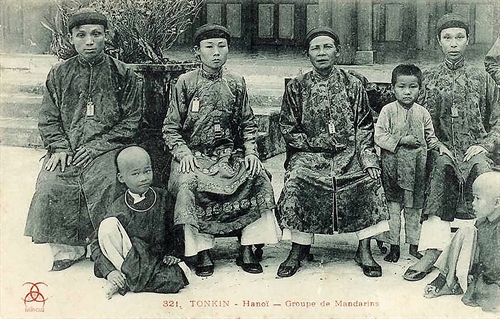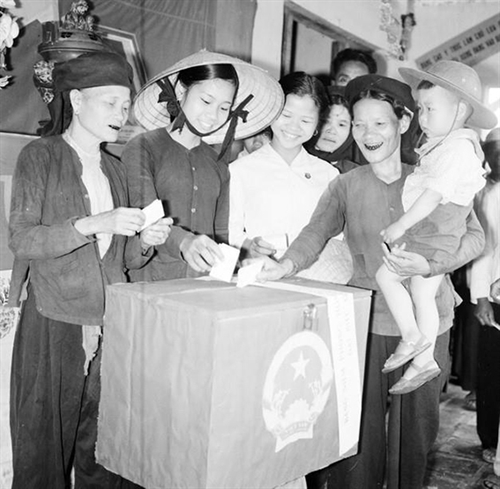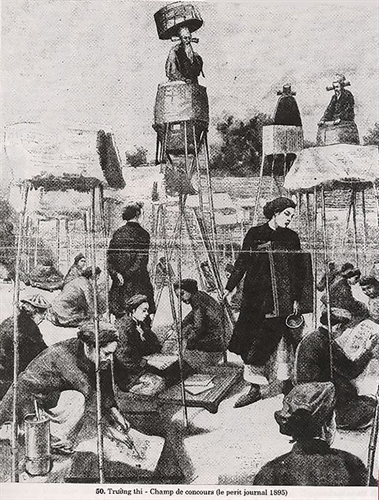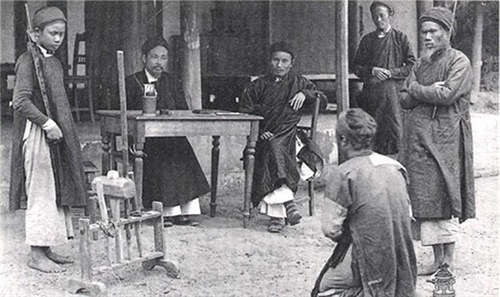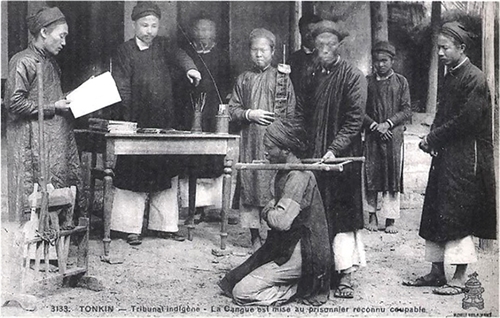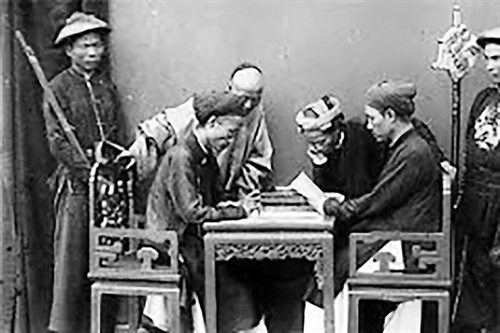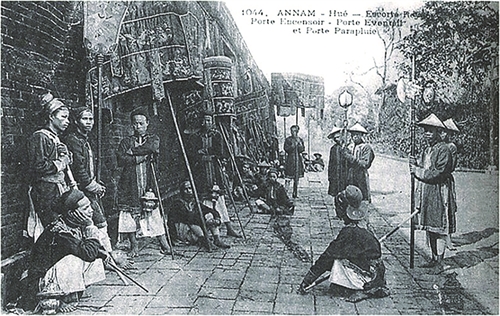Tran Hong Nhung, LL.D.
Hanoi Law University
Procedural law in feudal Vietnam from the 15th to 19th century
The procedural law and regulations in Vietnam during the 15th and 19 centuries were prescribed fairly comprehensively and specifically in “Quoc Trieu Hinh Luat” (the National Criminal Code) of the late Le dynasty and “Hoang Viet Luat Le” (the Royal Laws and Regulations of Vietnam) under the Nguyen dynasty. They were also codified into “Quoc Trieu Kham Tung Dieu Le” (the National Procedural Regulations of Royal Dynasties), which was really a distinctive legal phenomenon of the Vietnamese feudal laws.
Apart from these codes, the feudal states during this period also collected and systematized legal provisions by field and time in order to facilitate adjudication work. Of 29 documents listed by Historian Phan Huy Chu by subject matter in “Lich Trieu Hien Chuong Loai Chi” (Chronicles of Past Dynasties’ Charters) alone, 23 were about legal procedures[1]. Prominent ones include: “Tu Tung Dieu Le” - a collection of documents containing regulations on legal proceedings; “Nhan mang tra nghiem phap” which specified methods of collecting forensic evidences, methods of site inspection, ect.; “Quoc Trieu Hong Duc Nien Gian Chu Cung The Thuc” (Ways of making written lawsuits and records of criminal cases under Hong Duc’s tenure - 1470-1497); and“Quoc Trieu Chieu Lenh Thien Chinh”, a collection of royal decrees and orders adopted by Le dynasty’s kings and Trinh lords on issues under the jurisdictions of different ministries.
Based on historical materials and legal documents issued from the 15th to 19th century, a number of characteristics can be described of the procedural law in this period.
First, no clear-cut distinction was made between the executive and judicial branches. Chief mandarins at all administrative levels concurrently performed adjudication duties. This characteristic stemmed from the basic principle of power organization of the Vietnamese feudal states, namely the “Ton quan quyen” principle. Under this principle, all state powers were concentrated into the hands of one person, the king, without clear separation between the executive, legislative and judicial powers. The king was the only one with supreme adjudicative power. Mandarins handling domestic lawsuits were only the king’s representatives in the exercise of adjudicative power. In this period, all stages of the procedural process, from criminal case institution, investigation, arrest, post-mortem, search, questioning, prosecution, trial to judgment enforcement, were under the charge of chief local mandarins. In the then law, the conception of trial (adjudication) embraced all stages of the procedural process[2].
Second, having attached importance to the procedural law, as shown in their codification efforts, Vietnamese feudal legislators took an initial step in distinguishing the procedural law from the substance law[3].
In the 18th century, the feudal state under the Le-Trinh dynasty promulgated a separate code on legal procedures, “Quoc Trieu Kham Tung Dieu Le”, with the purpose of “setting a standard law with clear and accurate provisions for application by “nha mon” (yamen) to legal proceedings. “From that point on, the regulations were complied with so that cases were fairly and reasonably handled for the happiness of commoners…”[4] One year after this Code was completed in 1777, the royal court ordered the wood carving of the Code for distribution to royal offices and local “nha mon” and application nationwide.
“Quoc Trieu Kham Tung Dieu Le” had 133 articles arranged into 31 chapters. Chapter I dealt with procedural practices, with general provisions on the legal proceedings. Chapters II through XIV set forth specific procedures of each stage in the legal proceedings, such as the chapter on suers and complainants, the chapter on investigation duration, the chapter on arrest of convicts.Chapters XV through XXXI provided different procedures, such as the chapter on lawsuits related to human lives, the chapter on lawsuits related to burglary and robbery, the chapter on fighting, the chapter on marriage.
With such a clear and rational structure, the Code facilitated the application in case trials. Assessing its significance and importance, historian Phan Huy Chu wrote in “Lich Trieu Hien Chuong Loai Chi: “King Le Hien Tong, under his 38th reign year name of Canh Hung, amended the regulations on trials and lawsuits… The revised regulations were established with clear and detailed articles and clauses. The judges have the law at hand to make decisions, and have the cases to refer to. If these are strictly complied with, offenses will be reduced, hence less penalties and punishments”[5].
Third, regarding the procedural order, in the feudal time, commune mandarins were the first to hear cases and had jurisdiction to conduct trials. Under the early Le dynasty, “Quoc Trieu Hinh Luat” clearly stated in Article 672: “People in provinces and districts shall file their petty cases to commune mandarins; minor cases to provincial mandarins; medium cases to regional mandarins; all these mandarins must adjudicate the cases fairly and strictly according to law; meanwhile, big cases must be filed at the royal capital”. Under the Nguyen dynasty, “Hoang Viet Luat Le” (Article 376) and a number of legal documents provided that village chiefs were entitled to adjudicate small cases in villages. In 1834, King Minh Menh issued a decree on lawsuit-handling procedures, stating: “Minor cases such as insults, debts and fighting causing small wounds shall all be verbally adjudicated by village officials. In case of reported unfair trial, the lawsuits may be forwarded to district mandarins”[6].
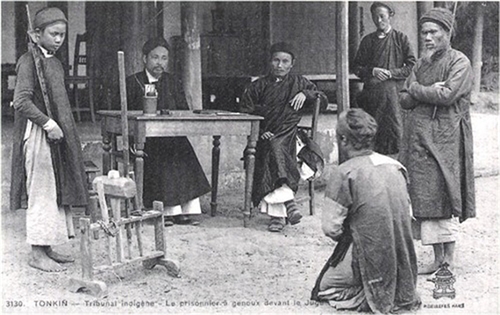 |
| An illustration of a court hearing in the Nguyen dynasty__Photo: Internet |
Historical and contemporary values of the Vietnamese procedural law from the 15th to 19th century
Firstly, the feudal procedural law contained provisions to protect the people’s legitimate rights and interests. According to “Quoc Trieu Hinh Luat”, those who filed lawsuits or complaints were entitled to appeal, requesting at least three appellate trials. Article 6 stated: “If for the reasons of official duties, parents’ death, or ailment, they can file written applications for trial postponement”. Such provisions aimed to ensure the interests of parties in the legal proceedings and facilitate the adjudication process. Article 687 further stated: “Those who file a protest for their innocence can express their opinions at court or in cross-examinations”.
It should be stressed that the protection of human rights in legal proceedings is not merely the recognition of legitimate rights of people. More importantly, it clearly and specifically determines the responsibility of mandarins in all procedural stages from submission of cases, denunciations to scene inspection, adjudication, judgment enforcement, etc., aiming to prevent violations of mandarins and to protect the legitimate rights and interests of people[7].
Secondly, the feudal procedural law was made towards a clean, transparent and public jurisprudence.
To ensure procedural fairness, feudal mandarins should possess impartiality and straightforwardness. The law severely punished acts of corruption in judicial activities to ensure mandarins’ integrity. According to Article 704 of “Quoc Trieu Hinh Luat”, jail superintendents or jailers who took bribes from offenders would be demoted three grades, for light offences; or subject to hard labor as public servants for serious violations. If asking for money so much that offenders completely lost their fortune, the offending mandarins were forced to hard labor in the army; or so much that the whole commune go bankrupt, they will be sentenced to exile or death and forced to pay compensation doubling the money sum they took by harassment. Upon hunting for offenders, if they received money as bribes from the latter or clandestinely inform them to escape, they would be charged as convicts. If they took bribes with a large volume of property, they must declare and list such property and be sentenced for bribery[8]. Upon hunting for convicts, if they took bribes from other persons who ask them to kill the offenders, they would be charged with murder as instigators or accomplices[9]. If yamen’s attendants maltreated convicts to death upon the hunt, they would be charged with deliberate murder[10]. During autopsy, if mandarins and their assistants took money for making false examination results, they would be charged with deliberate aggravation or mitigation of others’ offenses and be penalized according to law[11].
Aiming to give prominence to the judges’ independence and impartiality and restrict the abuse of power and self-seeking, “Quoc Trieu Kham Tung Dieu Le” provided: “Judging mandarins must not take cases at their own will or others’ insistence for help. They should consider the reasonability for official duty to be clear and accurate[12]. Mandarins who deliberately detained innocent people would be penalized with 80 strokes of heavy wood stick or be subject to hanging if the detainees died…[13]. Mandarins who, for their personal enmity, deliberately enforced death sentences against prisoners who were already pardoned, would be charged with deliberate aggravation of others’ crimes[14], The pronounced judgments must be publicly posted up for both parties to know or to appeal”[15].
The above-mentioned aspects are close to the perception of judicial integrity of modern law. This is also the progressive value of the feudal procedural law, which has been inherited and developed in the current law-making and enforcement process in Vietnam.
Thirdly, procedural oversight was emphasized.
The feudal states attached importance to procedural oversight in order to achieve high procedural effects. The supervision of adjudicative activities was prescribed in a separate chapter of “Quoc Trieu Kham Tung Dieu Le”, which was almost absent in “Quoc Trieu Hinh Luat” and “Hoang Viet Luat Le”.
It can be realized that the Vietnamese feudal states from the 15th to 19th centuries applied various modes and measures to oversee the adjudicative activities:
+ Superior mandarins supervised adjudication by subordinate mandarins.
+ Supervision via appellate trials: If first-instance judges correctly handled the cases, they would be rewarded with money (court fees). If not, they would be fined or even demoted or dismissed. In the feudal time, the superior procedural bodies could pick up first-instance cases for appellate trial in order to redress unjust sentences and report to the king on mistakes committed by their subordinates.
+ Procedural oversight through final jurisdiction: In the feudal time, cases were adjudicated at three levels: first-instance trial, appellate trial and final trial. With the supreme judicial power, the king made the final jurisdiction. All cases already adjudicated or approved by the king took immediate legal effect. The review of cases subject to capital punishment or the approval of judgments passed by Bo Hinh (Ministry of Justice) or Tam phap ty (three independent judicial offices) was, in nature, the exercise of supreme supervisory power of the king over the procedural bodies. In the Nguyen dynasty, in 1828 alone, of 800 death sentence cases reviewed, 150 were mitigated[16].
+ Annual procedural oversight: At the year-end, district and provincial mandarins had to report the numbers of adjudicated cases, existing cases, improperly handled cases, properly handled cases. On such basis, adjudicating mandarins would be penalized or rewarded.
Under the feudal law, the plaintiffs also had the right to oversee the procedural process conducted by mandarins and to request the summoning of persons related to their cases to courts. According to Article 1 of “Quoc trieu kham tung dieu le”, if “nha mon” conducted trials not according to regulations and showed signs of corruption, the plaintiffs could file their complaints to higher authorities[17]. In case of deception, they were entitled to file their written request to summon relevant persons to courts for questioning[18]. This provision ensured the oversight rights for participants in legal proceedings and also served as basis for determining whether their complaints were right or wrong. If complainants were mandarins, they were entitled to report it to the king or competent bodies.
By various measures, the State detected and handled many mistakes in the legal proceedings. According to “Dai Nam Thuc Luc Trieu Nguyen” (Chronicles of Great Vietnam under the Nguyen dynasty), 120 erroneous cases were discovered, including 19 cases of unjust adjudication, 11 cases of bribe taking; nine cases without judgments. Penalties included dismissal, relief from position, heavy stick strokes, exile or death, depending on the seriousness of violations. All cases of bribe taking thus leading to unjust adjudication were subject to death punishment.
Lessons from supervisory activities, error detection and handling remain valuable for the current judicial reform in Vietnam.
Fourthly, importance was attached to the recruitment and employment of procedural mandarins.
In the feudal time, adjudicating mandarins were heads of administrations at different levels. They were carefully selected in the course of appointment. Under King Minh Menh’s rule, special importance was attached to higher criteria of talent and education. The selection of people with talents and good virtues to be local mandarins was considered the primary important measure applied by the feudal states.
The inspection of procedural mandarins was carried out regularly, once every three years, under the Nguyen dynasty, with specific criteria. Mandarins adjudicating criminal cases had to report all adjudicated cases to Bo Hinh for review or transfer to Bo Lai (in charge of personnel and organization) for examination of mandarins’ gains or guilt[19].
Fifthly, many lessons were drawn from judgment enforcement.
To guarantee the effectiveness of judgment enforcement, the feudal states promulgated many regulations, clearly defining the time limits and responsibility there for. According to Article 697 of “Quoc Trieu Hinh Luat”, if the to be-confiscated material evidence was left untouched beyond the prescribed confiscation time limits (five months for a material evidence valued at 1,000 “quan” (a former unit of currency) or over; three months for a material evidence valued at 500 “quan” or over; one month and a half, for a material evidence valued at 100 “quan” or over; one month for a material evidence valued at 90 “quan” or less), the officials in charge would be punished with 80 strokes of heavy wood stick or demoted one grade if material evidence was left untouched for a longer duration. Mandarins penalized with dismissal or relieved from office would have their royal diplomas and certificates revoked within the prescribed time limit of three days. Beyond that time limit, the jail superintendent would be fined with five “quan” and the jailer would be punished with 30 rod whippings; the penalties would be one grade higher for every five-day delay, but not exceed 20 “quan” or 80 strokes of heavy wood stick.
It can be realized that despite limitations, the provisions of procedural law during Vietnam’s feudal period embraced progressive elements of contemporary international standards, such as the idea on a justice of integrity or the right to fair adjudication…. The then law also inherited and promoted the fine traditional national values such as unity, autonomy and village self-rule. The values of feudal procedural law should be applied in the context of globalization and international integration so that progressive legislative ideologies of mankind will be upheld while the national identities and cultural traditions will be preserved.-
- Administrative and territorial units. Local levels and the royal court had different adjudicating powers.
- Classification of cases and matters: “Quoc Trieu Hinh Luat” classified cases and matters into minor, medium and major ones; “Quoc Trieu Kham Tung Dieu Le” listed cases and matters in groups; “Hoang Viet Luat Le” classified cases and matters by offenses committed. On the basis of such classifications, the adjudicating jurisdiction of various levels was determined.
- At the central royal court, the adjudicating jurisdiction of different offices was determined according to their respective areas of management.
- The jurisdiction for first-instance trial and the jurisdiction for appellate adjudication.

